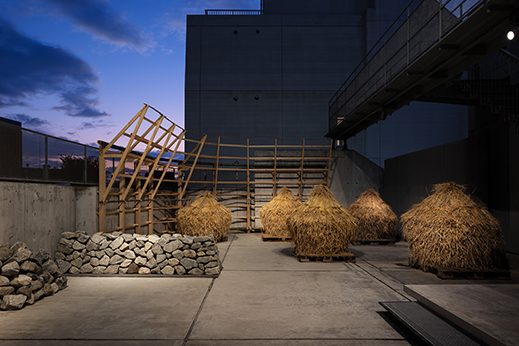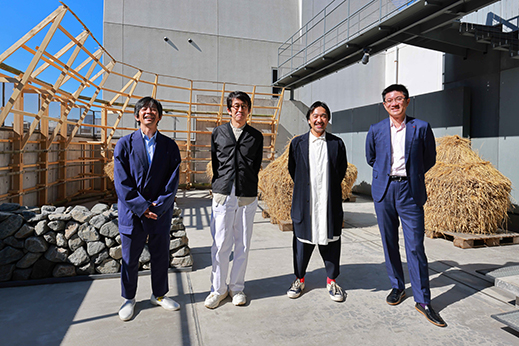 |
Focus features two in-depth reviews each month of fine art, architecture, and design exhibitions at art museums, galleries, and alternative spaces around Japan. |
|
|
 |
 |
 |
Architects Questioning Architecture: TOTO Gallery Ma Asks "How Is Life?"
James Lambiasi |
 |
Overall view of the How Is Life? exhibition at TOTO Gallery Ma, with Tool Shed in the center. Photo © Nacása & Partners Inc. |
I admit that when I visit an architectural exhibition, I have particular expectations regarding the way in which building design is communicated. As an architect myself, I find it a valuable reference to see how fellow practitioners answer to the task we take on, which is providing design services in response to the wants of society. In light of this expectation, I was surprised by the current exhibition at TOTO Gallery Ma, How Is Life? - Designing for Our Earth. Curated by architects Yoshiharu Tsukamoto, Manabu Chiba, Tsuyoshi Tane, and architectural historian Seng Kuan, this show is a respite from the norm in that the design and ideas of each exhibit simultaneously provide questions to ponder. In light of the growing worries of global warming, overpopulation, and depletion of our world resources, How Is Life? asks us to pause and think beyond the designs society tells us it wants and consider design ideas that we truly need to see past the trappings of our modern lifestyle. The exhibit themes vary in scope and originate from both Japan and abroad, but all are extremely relatable to the viewer, posing alternatives to our current lifestyle and helping us to ultimately ask ourselves, how is my life?
|
 |
|
|
|
Exhibit of repurposed items by ReBuilding Center Japan. Photo by James Lambiasi
|
The centrally located exhibit entitled Tool Shed recognizes the core theme of the exhibition: the rapid consumption rate of modern society that has outpaced the available resources of our earth. Tool Shed is a collaborative display of many of the tools that are used in some of the featured projects, such as hand saws, hoes, and scissors. These implements of manual labor that helped our ancestors survive and live off the bounty of nature could be seen as a subtle reminder that this direct connection to life-sustaining activities acted to moderate our consumption and enabled us to live in harmony with the earth.
Located in Nagano, ReBuilding Center Japan is a warehouse, workshop and café that salvages materials from local demolished houses and repurposes these otherwise unused resources into usable objects.
While taking a nostalgic look to the past, their exhibit lets us appreciate construction materials transformed into new and useful products through ingenious design. A lid of a traditional rice cooker serves as a stool, window glass forms an intricate lamp shade, and who knew that a table leg could be such a perfect pepper mill?
 |
|
Exhibit of stacked thatch by Collective Thatching. Photo © Nacása & Partners Inc. |
Collective Thatching brings to our attention the disappearing art of thatched roofing, and the fact that in many cases traditional skills depend on not just one individual skilled worker, but the coordinated efforts of a whole community. While the need for thatched roofing created by the collaborative yui system may never return to what it once was, this exhibit underscores the fact that traditional work patterns had benefits far greater than the current construction industry that treats work as a contract. In this respect it encourages us to contemplate our own work conditions, and perhaps ask ourselves if our current workstyle is one of human interdependence or of isolation.
Detail view of the Bicycle Highway exhibit. Photo by James Lambiasi |
Bicycle Urbanism, proposed by Chiba Manabu Architects + Manabu Chiba Lab at the University of Tokyo, poses the question "What if cities were designed around the bicycle?" Cycling as a transportation method has obvious benefits of using fewer resources to provide power. This exhibit, however, reminds us that the scale of our streets and building designs has slowly evolved to accommodate the high-speed modes of car and train, and have consequently created an urban environment less connected to us as humans. Visualized as a blue highway, the large-scale model Bicycle Highway offers a view of a world where bicycle traffic is welcomed into the center of the street, and even into building interiors.
Exhibit of Kuwamizu Sento. Photo by James Lambiasi |
The exhibition also includes representations of completed buildings that respond to community needs. Kuwamizu Sento is a public bath project in Kumamoto which was built in response to community needs after the major earthquake of 2016. The most interesting aspect of this bathhouse in relation to the exhibition is its unorthodox combination of private and public space, in that the building itself is actually the owner's private house, which was opened to the community to help cope with the lack of bathing facilities after the disaster. The public bath zone on the ground floor is open during designated hours, and at other times is used by the family. This redefining of private space is an encouraging example of how our modern notions of living are actually quite malleable; with a fresh sense of vision, we can focus on sharing resources for the benefit of our surrounding community.
As the title indicates, How Is Life? was created by its curator team with the aim of posing questions about how we live our lives. The broad spectrum of exhibits shares a common thread of suggestions on ways we might adjust our own lives in awareness of the increasingly evident limitations of our planet's resources. Hopefully, those of us who experience this exhibition will ask ourselves these questions and continue this dialogue for the sake of our own future.
 |
|
Planning and Management Committee members (left to right) Yoshiharu Tsukamoto, Manabu Chiba, Tsuyoshi Tane, and Seng Kuan. |
All photos provided by or taken with the permission of TOTO Gallery Ma. |
 |
 |
James Lambiasi
Following completion of his Master's Degree in Architecture from Harvard University Graduate School of Design in 1995, James Lambiasi has been a practicing architect and educator in Tokyo for over 26 years. He is the principal of his own firm James Lambiasi Architect, has taught as a visiting lecturer at several Tokyo universities, and has lectured extensively on his work. James has served as president of the AIA Japan Chapter in 2008, and frequently appears on the NHK series "Journeys in Japan" as an architectural critic.
|
|
 |
|